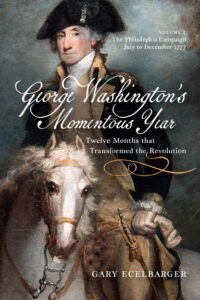BOOK REVIEW: George Washington’s Momentous Year: Twelve Months that Transformed the Revolution—Volume 1, The Philadelphia Campaign by Gary Ecelbarger (Yardley, PA: Westholme Publishing, 2004. $32.50, hardcover)
Gary Ecelbarger is a skilled writer who weaves an interesting account of Gen. George Washington’s leadership and campaign management challenges in this, the first of a planned two-volume analysis. This text, Volume I, addresses July to December 1777. Volume II is slated to address December 1777 to July 1778, completing his coverage of a critical one-year period.
 Readers frequently explore new texts on George Washington because he is a complex individual and military commander. Ecelbarger’s text adds to the growing body of work that examines Washington as he struggled with the many challenges of leading a new and inexperienced army against perhaps some of the world’s most capable military forces. Readers with little or extensive background knowledge on the revolution and Philadelphia campaign will enjoy the author’s approach. He consulted an extensive list of primary and secondary sources as well as seeking council from numerous subject matter experts in preparing this text.
Readers frequently explore new texts on George Washington because he is a complex individual and military commander. Ecelbarger’s text adds to the growing body of work that examines Washington as he struggled with the many challenges of leading a new and inexperienced army against perhaps some of the world’s most capable military forces. Readers with little or extensive background knowledge on the revolution and Philadelphia campaign will enjoy the author’s approach. He consulted an extensive list of primary and secondary sources as well as seeking council from numerous subject matter experts in preparing this text.
This text stands apart from others for several reasons. The author focuses on the command-and-control issues Washington faced throughout the campaign. Ecelbarger’s analysis is particularly refreshing because he holds Washington accountable for his failure to achieve the mission success he set out to secure during the campaign. Washington frequently assigned tasks to his subordinate commanders that they were unable to successfully complete and the ultimate responsibility clearly rested with the commander, Washington. However, Ecelbarger is not overly critical of Washington but highlights his lack of timely decision making, inferring he lost multiple opportunities to pursue other courses of action or to strike directly at portions of the British army.
The text is organized chronologically in thirteen readable, well organized and easily digestible chapters. Readers will find eleven detailed maps that assist in viewing specific battlefield and broader campaign maneuvers described in the narrative. These illustrations are professionally prepared and extremely helpful. These maps graphically display the extensive maneuver undertaken by Washington throughout the campaign. The text holds the reader’s interest because the author introduces the human elements of leadership into his analysis. Personalities always matter and Ecelbarger introduces the reader to some well know and some lesser-known individuals. He does not attempt an in-depth analysis but points out the impact all these individuals and their behavior had on the broader issue of command and control. He even brings the reader into the homes of citizens where Washington set up his mobile headquarters and dined with his staff.
This text begins with Washington’s attempt to position his army to address Gen. William Howe’s confusing maneuvers during July and August 1777 that ultimately lead to the Battle of Brandywine. All this is clear to us today, but at the time Washington’s key subordinates were convinced Howe intended to advance up the Hudson River to link with a British army moving south from Canada. This highlights a constant problem faced by the Patriots, the mobility provided by British naval power. The British could move large formations by water while the Patriots were forced to counter with land-based forces that moved more slowly. During the initial phase of the campaign the army marched and countermarched until reliable intelligence placed Howe in the Chesapeake Bay. Howe elected to land at the head of the Elk River in Maryland, approaching Philadelphia from the south. Unfamiliar with the terrain, Washington was unable to establish an effective fixed defense. The terrain favored a mobile defense, something his inexperienced army was inadequately trained to accomplish.
The text ends somewhat abruptly after the Battle of Whitemarsh in early December 1777. However, Ecelbarger briefly introduces the reader to the French diplomats who later came to the aid of the Americans. This provides a transition with the understanding the story will continue in a subsequent volume. Yet in early December 1777, Washington’s Continental Army had been driven from the battlefield six times since August, at Cooch’s Bridge, Brandywine, White Horse Tavern, Paoli, Germantown, and Fort Mifflin. The author points out the Continental Army suffered tactical loss but it was the British commander, General Howe, who offered his resignation, not Washington. As volume one concludes, Ecelbarger makes it clear that Washington’s army did not view itself as defeated. Soldiers and leaders believed they were winning the war. The army reflected what Gen. Charles Lee previously described as a “noble spirit” that could save the revolution.





Recent Articles
Lt. Elijah Evans of Maryland: Unresolved Promotion in an Extra Continental Regiment
A Journey North: Jefferson, Madison, and the Forging of a Friendship
New Jersey’s Revolutionary Rivalry
Recent Comments
"The Evolution of the..."
This article is a gem. Sparkling. Excellent research. Wide and deep. Thank...
"The Evolution of the..."
A very interesting article, thank you! A more general question, if you...
"The Evolution of the..."
Thoroughly researched and a succinct presentation, especially given the article's breadth.